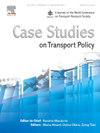Understanding the uneven use of rental e-scooters and implications for equity: Evidence from England’s largest e-scooter trial
IF 2.4
Q3 TRANSPORTATION
引用次数: 0
Abstract
The availability and adoption of rental e-scooter services, proliferating in cities globally, are spatially and socially uneven. Studies suggest that a majority of users in North American and European cities are men with higher incomes and more education than the average. The use of shared e-scooters by sociodemographic groups that are more likely to have access to a car and a wide range of opportunities raises questions as to whether this new transport technology entrenches inequalities. However, few studies focus on e-scooter use in England, where only shared e-scooters permitted and regulated by the UK’s Department for Transport alongside relevant local governments on a trial basis are legal for travel on the public highway. These services were therefore often introduced to achieve policy objectives, and the government commissioned a national evaluation of the e-scooter trials in English cities to understand their impacts. The evaluation report suggests they are popular among low-income and minority ethnic riders, but highlights the need for further study, such as the one presented here. This article uses a transport poverty framing and a dataset of 3.6 million e-scooter trips taken over 13 months in Bristol to investigate the uneven sociodemographic and spatial patterns of rental e-scooter use. We find that, holding all else equal, more e-scooter trips are taken from areas with larger shares of younger (under 35), black and Asian individuals. However, there are fewer e-scooter trip origins from areas of greater deprivation in Bristol. This suggests that while younger, Black, and Asian populations may be more likely to adopt or have access to e-scooters as a mode of transport, fewer e-scooter trips from areas of greater deprivation indicate potential barriers to access or adoption in these communities.
了解租赁电动滑板车的不平衡使用及其对公平的影响:来自英国最大的电动滑板车试验的证据
租赁电动滑板车服务的可用性和采用在全球城市激增,在空间和社会上是不平衡的。研究表明,北美和欧洲城市的大多数用户都是收入和受教育程度高于平均水平的男性。更有可能拥有汽车和更多机会的社会人口群体使用共享电动滑板车,这引发了一个问题,即这种新的交通技术是否会加剧不平等。然而,很少有研究关注电动滑板车在英国的使用情况,在英国,只有由英国交通部和相关地方政府批准和监管的共享电动滑板车才能在公共公路上合法行驶。因此,这些服务经常被引入以实现政策目标,政府委托对英国城市的电动滑板车试验进行全国性评估,以了解其影响。评估报告表明,它们在低收入和少数民族骑手中很受欢迎,但也强调了进一步研究的必要性,比如这里展示的研究。本文使用交通贫困框架和在布里斯托尔超过13个月的360万次电动滑板车旅行的数据集来调查租赁电动滑板车使用的不平衡的社会人口和空间模式。我们发现,在其他条件相同的情况下,更多的电动滑板车出行来自年轻人(35岁以下)、黑人和亚洲人比例更高的地区。然而,在布里斯托尔,来自贫困地区的电动滑板车出行人数较少。这表明,虽然年轻人、黑人和亚洲人可能更有可能采用或有机会使用电动滑板车作为一种交通方式,但来自贫困地区的电动滑板车出行次数较少,这表明这些社区在使用或采用电动滑板车方面存在潜在障碍。
本文章由计算机程序翻译,如有差异,请以英文原文为准。
求助全文
约1分钟内获得全文
求助全文

 求助内容:
求助内容: 应助结果提醒方式:
应助结果提醒方式:


